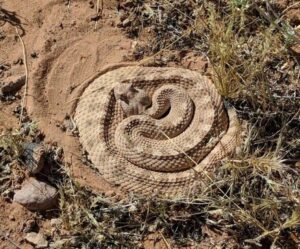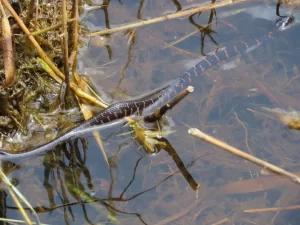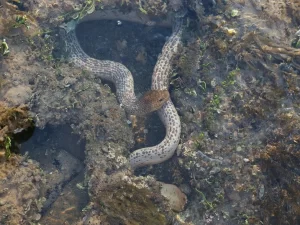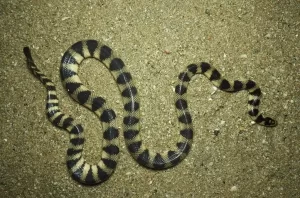All snakes can swim to some extent, and many can dive underwater to hunt for food. But how long can snakes stay underwater?
Generally, most terrestrial snakes can stay underwater for 1 to 10 minutes, while more aquatic snakes such as water snakes can stay submerged for up to 30 minutes. Sea snakes have specialized adaptations, and can stay underwater for as long as 2 hours.
That said, it is important to note that not all snake species are capable of diving underwater.
Terrestrial snakes generally lack the adaptations for prolonged diving, and will typically only swim in shallow water.
However, many species (not all) can still go underwater for brief periods if needed.
Terrestrial Snakes Can Only Stay Underwater for a Few Minutes
Terrestrial snakes (like Rattlesnakes), are best adapted for a life on the ground.
These snakes live in a variety of terrestrial environments, including grasslands, woodlands, forests, or even deserts, and mountains.

While they can swim, terrestrial snakes will typically avoid deep water, and can only go underwater for brief periods (generally 1 to 10 minutes).
They are not not true divers like more aquatic snake species, will usually only submerge when necessary (eg, to escape a predator).
Water Snakes Can Stay Underwater for up to 30 Minutes
Water snakes are characterized by their semi-aquatic lifestyle, and spend a significant time in or near freshwater bodies such as rivers, swamps, or lakes.

These snakes are very strong swimmers and can stay underwater anywhere from 10 to 30 minutes.
For example, Plain-bellied water snakes (Nerodia erythrogaster) have been observed submerged underwater for over 10 minutes, and lying in wait for prey to approach.
Sea Snakes Can Stay Underwater for Several Hours
Sea snakes are the most aquatic snakes and live in marine environments for most of their lives.
These snakes are highly adapted for their semi aquatic life and often dive to the sea floor to hunt – staying submerged for up to 2 hours before returning to the surface for air.

For example, Olive sea snakes (Aipysurus laevis) are known to frequently spend up to two hours underwater before returning to the surface to breathe.
A few species of sea snakes can even stay underwater for up to 8 hours!
How Long a Snake Can Stay Underwater Is Mainly Dependent on 3 Factors
How long a snake can stay underwater after is mainly dependent on 3 factors, namely: the species, how active the snake is, and the temperature.
Depending on these factors, diving snakes can stay underwater anywhere from 15 minutes, to several hours.
1. Species
Some snake species are more adept at holding their breath than others and thus can stay underwater longer.
As mentioned above, Olive sea snakes (Aipysurus laevis) are known to spend up to two hours underwater before returning to the surface to breathe.
Other snakes may only spend 15 to 30 minutes underwater before returning to the surface for air.
2. How Active the Snake Is
Activity affects how much oxygen the body needs.
Think about it. When you are running or jogging, you breathe in much quicker breaths than when you are lying on the couch.
For snakes, this is also true. Their oxygen demands will be influenced by their activity levels.
A snake that is resting on the bottom of the water may be able to stay submerged for a significant amount of time.
On the other hand, an individual of the same species who is escaping a predator or chasing prey – may only be able to stay underwater for a few minutes before needing to surface to replenish its oxygen supply.
3. Temperature
Like all reptiles, snakes are cold-blooded (ectothermic) animals.
This means they cannot internally regulate their body temperature. Instead, their body temperature changes with the temperature in their surroundings.
In other, their environment is the main influence on their body temperature.
For example, a snake swimming in 30°C (86°F) water has a body temperature very close to 30°C. In water at 15°C (59°F), the body temperature is around 15°C.
Being ectothermic means snakes will have a varied rate of metabolism, depending on the water temperature.
Warmer water temperatures increase metabolic rates. This means snakes have to resurface more often to get oxygen.
On the opposite end, cooler water allows snakes to conserve oxygen. This extends the time they can hold their breath.
The Snakes Can Can ‘Breathe’ Underwater
Although snakes need to resurface to breathe air, some species have found ways to top up their oxygen levels while submerged.
A team of researchers analyzed the bodies of two blue-banded sea snakes (Hydrophis cyanocinctus) – and discovered a gill-like network of blood vessels in the animals’ heads.

This complex system of blood vessels is known as a modified cephalic vascular network (MCVN).
It is located just under a broad area of skin between the snout and the roof of the snake’s head.
While the MCVN is structurally very different from the gills of fish, its function is similar. It provides a large surface area packed with oxygen-depleted blood vessels.
The oxygen-poor blood in these vessels is able to absorb oxygen from the surrounding water – through the skin.
The blood oxygenated blood is then carried to the brain – very similar to how a fish’s gills work.
In this way blue-banded sea snakes use the top of their head, as a sort of gill, to breathe underwater.
This ‘skin breathing’ is known as cutaneous respiration, and is very unusual for reptiles, because their skin is thick and scaly.
That said ,blue-banded sea snakes still need to surface in order to breathe air, but the MCVN allows them to do so much less frequently than would otherwise be the case.
Conclusion
Snakes live in a wide variety of environments and often encounter water bodies in their habitats.
All snakes can instinctively swim, but not all species can dive underwater.
Snakes that can dive will hold their breath while submerged, and only breathe when they resurface.
Depending on the species, and other factors, snakes can stay underwater anywhere from 1 minute, to as long as 2 hours.
Generally, water snakes and sea snakes have adaptations that enable them to stay submerged for longer periods than terrestrial snakes.
Hi, my name is Ezra Mushala, i have been interested animals all my life. I am the main author and editor here at snakeinformer.com.

